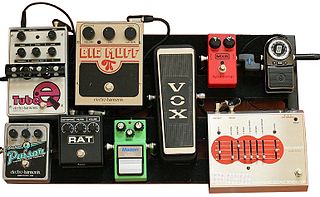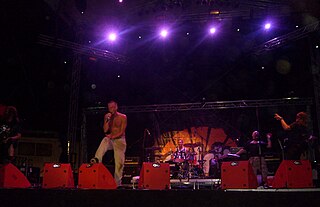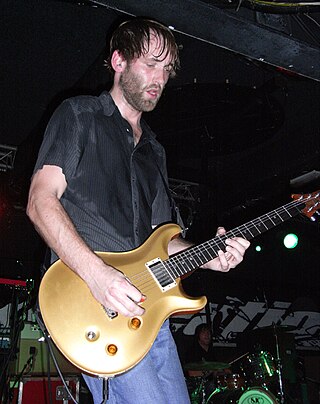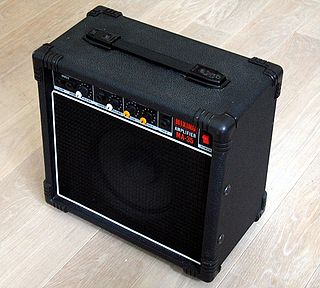
An effects unit or effects pedal is an electronic device that alters the sound of a musical instrument or other audio source through audio signal processing.

The acoustic bass guitar is a bass instrument with a hollow wooden body similar to, though usually larger than a steel-string acoustic guitar. Like the traditional electric bass guitar and the double bass, the acoustic bass guitar commonly has four strings, which are normally tuned E-A-D-G, an octave below the lowest four strings of the 6-string guitar, which is the same tuning pitch as an electric bass guitar.

Paul Landers is a German musician, notable as the rhythm guitarist for the Neue Deutsche Härte band Rammstein, and the punk rock band Feeling B.

Clawfinger is a Swedish rap metal band from Stockholm. The group is known for aggressive but melodic music and tackling political and anti-racist themes in their songs.

The baritone guitar is a guitar with a longer scale length, typically a larger body, and heavier internal bracing, so it can be tuned to a lower pitch. Gretsch, Fender, Gibson, Ibanez, ESP Guitars, PRS Guitars, Music Man, Danelectro, Schecter, Jerry Jones Guitars, Burns London and many other companies have produced electric baritone guitars since the 1960s, although always in small numbers due to low popularity. Tacoma, Santa Cruz, Taylor, Martin, Alvarez Guitars and others have made acoustic baritone guitars.

Clawfinger is the third studio album by Swedish rap metal band Clawfinger, released on 29 September 1997 through WEA and MVG labels.

Isaac Delahaye is a Belgian guitarist and composer, best known as the lead guitarist of Dutch symphonic metal band Epica since 2009. Prior to that he was lead guitarist in the Dutch death metal band God Dethroned. Delahaye replaced former guitarist Jens van der Valk in God Dethroned after van der Valk left in 2004. He joined the band after a request from drummer and longtime friend Ariën van Weesenbeek and after several meetings with van Weesenbeek and Henri Sattler, Delahaye was welcomed into the band on 29 June 2004. On 15 January 2009, the official announcement came that Isaac was no longer a part of God Dethroned. Soon afterwards, an announcement came from the band Epica that proclaimed Delahaye as their recently hired guitarist.

Kenneth Shaun Hickey is an American heavy metal musician. He was the co-founder, guitarist and backing and occasional co-lead vocalist of the gothic metal band Type O Negative. He is currently the vocalist and guitarist for heavy metal band Silvertomb and was the co-founder of Seventh Void. All three bands also feature fellow Type O Negative member Johnny Kelly on drums. Hickey is also an occasional touring guitarist for Danzig.

Dave Knudson is an American guitarist and founding member of Seattle based indie band Minus the Bear, as well as mathcore band Botch. Other credits include additional guitars on These Arms Are Snakes' album Oxeneers or The Lion Sleeps When Its Antelope Go Home. Since the breakup of Minus The Bear, Knudson has been working on solo material; his debut solo album, The Only Thing You Have to Change is Everything, was released on May 13, 2022.

Daniel Joseph Donegan is an American musician who serves as the guitarist and keyboardist for heavy metal band Disturbed.

Dave Meros, is an American bass guitar player, best known as the bass player for progressive rock band Spock's Beard. Meros has also played or recorded with such artists as Gary Myrick, Bobby Kimball of Toto, Simon Phillips, Mark Lindsay of Paul Revere and the Raiders and Big Big Train, and played for Eric Burdon and The Animals from 1990 through the end of 2005, and was the bass player for Iron Butterfly from 2015 through 2021. He was also tour manager for Eric Burdon and has worked as a tour manager for further artists as well. As a bassist, Meros' musical influences are varied, including Paul McCartney, John Entwistle, Chris Squire, James Jamerson, Marcus Miller, Francis "Rocco" Prestia of Tower of Power, Chuck Rainey and David Hungate.

Peter Hayes is an American musician and singer, best known as a member of the rock band Black Rebel Motorcycle Club.

A bass amplifier is a musical instrument electronic device that uses electrical power to make lower-pitched instruments such as the bass guitar or double bass loud enough to be heard by the performers and audience. Bass amps typically consist of a preamplifier, tone controls, a power amplifier and one or more loudspeakers ("drivers") in a cabinet.

Björn Gelotte is a Swedish musician and songwriter, best known as the lead guitarist for heavy metal band In Flames. He originally joined the band as the drummer in 1995, and continued in this position during The Jester Race (1996) and Whoracle (1997). He switched to his current position on lead guitar after Glenn Ljungström left the band and played solely guitars since Colony (1999), sharing lead/rhythm guitar work with former In Flames guitarist Jesper Strömblad.
Re-amping is a process often used in multitrack recording in which a recorded signal is routed back out of the editing environment and run through external processing using effects units and then into a guitar amplifier and a guitar speaker cabinet or a reverb chamber. Originally, the technique was used mostly for electric guitars: it facilitates a separation of guitar playing from guitar amplifier processing—a previously recorded audio program is played back and re-recorded at a later time for the purpose of adding effects, ambiance such as reverb or echo, and the tone shaping imbued by certain amps and cabinets. The technique has since evolved over the 2000s to include many other applications. Re-amping can also be applied to other instruments and program, such as recorded drums, synthesizers, and virtual instruments.

William Breen Kelliher is an American musician, best known as the rhythm guitarist of heavy metal band Mastodon, and being the only band member who doesn't share the lead vocal duty.
An eight-string bass guitar is a type of bass guitar with double course strings normally tuned in octaves, with both strings in a course usually played simultaneously. As on a 12-string guitar, this produces a natural chorus effect due to the subtle differences in string timbre.
A nine-string guitar is a guitar with nine strings instead of the commonly used six strings. Such guitars are not as common as the six-string variety, but are used by guitarists to modify the sound or expand the range of their instrument.

This is a list of jazz and popular music terms that are likely to be encountered in printed popular music songbooks, fake books and vocal scores, big band scores, jazz, and rock concert reviews, and album liner notes. This glossary includes terms for musical instruments, playing or singing techniques, amplifiers, effects units, sound reinforcement equipment, and recording gear and techniques which are widely used in jazz and popular music. Most of the terms are in English, but in some cases, terms from other languages are encountered.

A keyboard amplifier is a powered electronic amplifier and loudspeaker in a wooden speaker cabinet used for amplification of electronic keyboard instruments. Keyboard amplifiers are distinct from other types of amplification systems such as guitar amplifiers due to the particular challenges associated with making keyboards sound louder on stage; namely, to provide solid low-frequency sound reproduction for the deep basslines which keyboards can play and crisp high-frequency sound for the high-register notes. Another difference between keyboard amplifiers and guitar/bass amplifiers is that keyboard amps are usually designed with a relatively flat frequency response and low distortion. In contrast, many guitar and bass amp designers purposely make their amplifiers modify the frequency response, typically to "roll off" very high frequencies, and most rock and blues guitar amps, and since the 1980s and 1990s, even many bass amps are designed to add distortion or overdrive to the instrument tone.


















